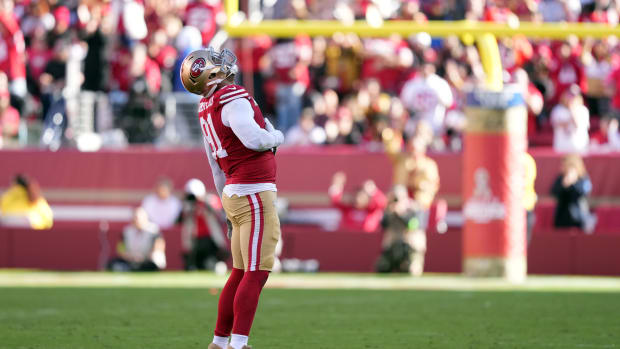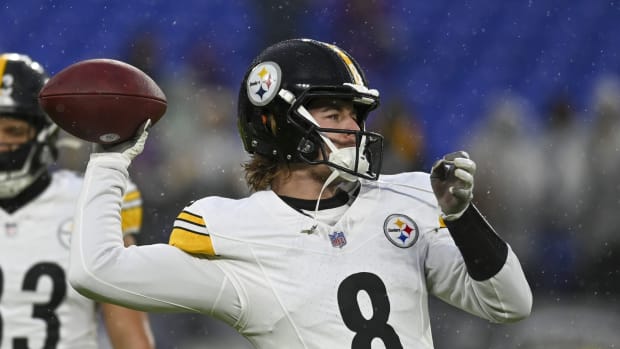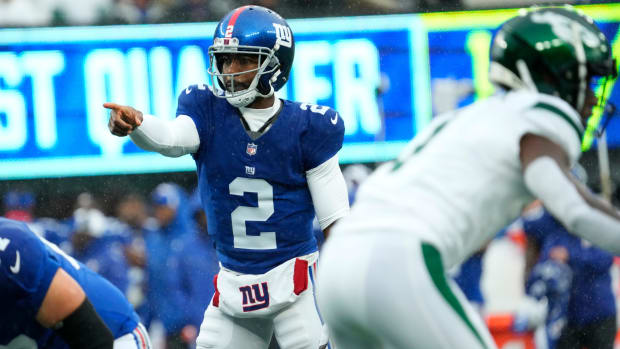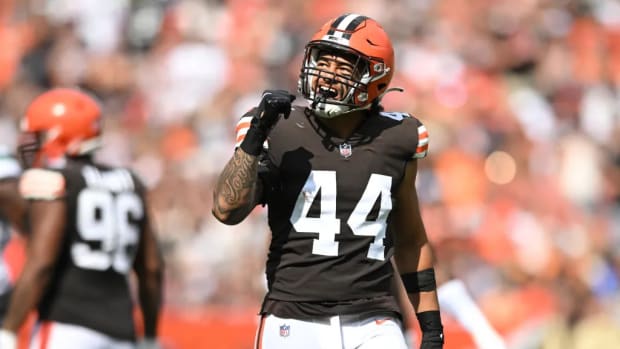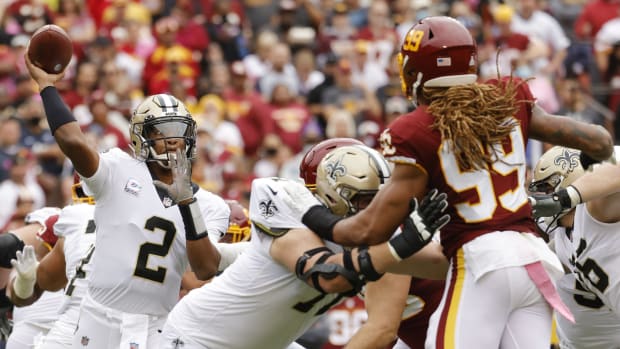
Pressure Points: McCoy's Great Awakening
Fair warning to future Buccaneers opponents: thanks to a talk with coach Greg Schiano and tutoring from a Hall of Famer, defensive tackle Gerald McCoy has been unleashed.
After spending most of the season being used in puzzling ways—as the sacrificial penetrator on a stunt, for instance—the fourth-year pro and former third overall pick is now become the focal point of a Buccaneers pass rush that is improving.
The result? McCoy set the season high for interior rushers with 7.25 Pressure Points after posting two solo sacks, one assisted sack, six hurries and two quarterback hits against the Falcons. McCoy has now vaulted into the second spot among interior rushers for the season with a 8.7 pressure rate, behind leader J.J. Watt (11.1).
Two things signaled a change for McCoy. The first was a trip to Schiano’s office to ask for an increased role, and tutelage from Hall of Fame defensive tackle Warren Sapp. Sapp’s recent comments about being puzzled by how the Bucs were using McCoy triggered his consultation with Schiano.
“That's definitely the case,” McCoy said. “The great thing about Coach is, he leaves his door open for all players to come up there and talk to him and offer suggestions. I went up there, his door was open, I asked if I could speak with him for a second and he said, 'Yeah, come on in.' We sat down, talked for a little bit, and then he talked with some of the other players. After that, he came up with a great gameplan and it's been working for us.”
At 6-4, 300 pounds and blessed with amazing athleticism, some probably attribute McCoy’s success to his genetic gifts. But as with all emerging pass rushers, there’s a subtle art to consistent success in getting after the quarterback.
Take McCoy’s second sack against Matt Ryan. It certainly helped that McCoy was going against a converted center, Peter Konz, at right guard for Atlanta, but it’s McCoy’s hands that keyed this sack. When Konz tried to punch McCoy, he took Konz’s outside hand and threw it inside. That allowed McCoy to gain leverage, and the play was basically over. That move may look familiar to long-time Buccaneers fans.
“That was a move I learned from Warren Sapp,” McCoy said. “It was one of his go-to moves that he used for years. Regardless of whether they knew what it was or not, they couldn't stop it. And I've just been working on perfecting it and it's working for me.” McCoy and Sapp often consult during the course of the week.
“We haven't worked on the field, but it’s more film work and just talking over the phone,” McCoy said. “He'll watch me on tape and let me know what I need to do and we'll just talk back and forth.”
On McCoy’s first sack, he beat a double team with a sack assist from right end Daniel Te’o-Nesheim, who got Ryan to step up into the pocket and into McCoy.
“It was a base call and I think we had a tag on it where we play pass first and run second. It's not always like that,” McCoy said. I saw (Konz’s) hand sitting lighter and I got my read and looked to my left and saw the tackle looking right down at me. So I said, 'OK, I'm about to get a vice, a deuce block (double team). But it's going to be a pass.' So when I came off the ball, I immediately came off and tried to split the double, just tipping my hips toward the guard and getting his hands down. I knew if I could get the guard's hands down, I had a pretty good chance to split it because the tackle is going to go back and help the tight end. That was kind of my mindset.
“Teo had two good rushes back to back. We've been working with each other on his top move. He worked on it all week and it worked during the game.”
Now that McCoy has been freed up by the coaching staff, a lot of things are working for the Bucs defense in getting after the quarterback.
Unsung edge rusher of Week 11
Carlos Dunlap, Bengals
The record-setting week continues to edge rushers as well. Not only is Dunlap a repeat winner from Week 10 as the Bengals continued to pick up the slack from Geno Atkins’ injury, but he set a Pressure Points record—edge and interior—with 7.5 against the Browns. However, Dunlap rushed the quarterback 55 times, which is tied for fifth-most in a single game (the most is 60 by New England’s Chandler Jones vs. Atlanta), so that number is a bit skewed. (The 5.75 points Rams end Robert Quinn had in 24 rushes vs. the Seahawks was the best rate in a single week).
Even with the high number of rushes, Dunlap was still impressive enough to also earn the Unsung Edge Rusher award this week. Dunlap had only one sack—and it was an “easy” coverage sack assisted by Domata Peko—yet he also had a drawn hold, nine hurries and three hits.
Unsung interior rusher of Week 11
Marcell Dareus, Buffalo Bills
They’ve been a little bit hidden out in Western New York away from the national media, especially with a 4-7 record, but the Bills have been building a formidable pass rush, and it starts with the emerging interior tandem of tackles Kyle Williams and Marcell Dareus.
Despite not having a sack, Dareus’ one drawn hold, three hurries and a hit against the Jets were enough to place third among interior rushers this week. Right behind him was Williams, who had a solo sack, an assisted sack and one hit. For the season, Williams is sixth and Dareus is now tied for 10th among interior rushers.
“Our relationship on the field is pretty strong,” Dareus said. “Kyle's been showing me little things as we've been going along. We've kind of gelled. I know what he likes to do and he knows what I like to do and we just kind of feed off each other. He's more of get-off rusher and I'm more of a power rusher and we feed off each other. I can push the power and I know he can get off and I can hold the double team if needed. It's a good combination of what we've been working on the past couple of years.”
The Bills also have surprising outside linebacker Jerry Hughes, who was a disappointing first-round pick of the Colts, up to fourth among edge rushers this season. Dareus said all of that success goes back to the scheme of defensive coordinator Mike Pettine, and the consistency with the coaching staff.
“We just need some consistency,” said Dareus, the third overall pick in 2011. “My coaching staff is being consistent with us and showing us different things and letting us play our techniques. In the previous years, I had two defensive coordinators, two different techniques and I still had to play different positions on the defensive line. It's kind of just been scattered about. I just like the defense this year. I feel like I could have been doing this earlier, there just wasn't as much consistency as I was hoping or looking for. We put a good scheme together and played hard, but now we have consistency.
“We're trying to change the culture here. Not just winning games, but the culture and identity of the team. That's our main focus right now. The attitude is what we're looking for right now. If we keep busting our butts the wins will come, we just have to keep working at it.”
* * *
* * *
Our Methodology
One of biggest indicators of success for NFL defensive coaches is the ability to affect the quarterback.
Sure, that means sacks, which are an official NFL statistic. And quarterback hits, which are also tallied in press boxes. But affecting the quarterback, making him feel pressure, has several other factors, most of which aren’t officially tallied (though NFL teams do them internally).
We at The MMQB thought long and hard about finding a better way to evaluate quarterback pressure, both from individual and team standpoints. We’ve developed our own formula, which we think will highlight players who aren’t getting the glory stats (sacks) but are still affecting the quarterback just as much.
The two statistics that we’ll be tabulating are sack assists and drawn holds. The latter is self-explanatory. Pass rushers are sometimes held by offensive lineman before they can sack the quarterback. Those plays aren’t official plays for the NFL. But they can be nearly as damaging. It’s a 10-yard foul, although there is no loss of down.
A sack assist is given to a player who allows a teammate to get a sack. You see it all the time. One player comes flying at a quarterback, causing him to bolt, and the QB winds up in the arms of a different defender. Sometimes the sacker didn’t do very much, yet he still gets credit for the sack. The player who actually caused the sack gets nothing. We’re going to change that.
Here’s how the formula works.
Sacks
Because not all sacks are created equally, we have divided up sacks into three categories: solo, assisted andeasy.
Solo sack (1.25 points): For the player who beats a blocker and gets the sack on his own. These are the real sack masters; they should be rewarded for their standout individual effort.
Assisted sack (.75 points): Given to the player who officially receives a sack but had help from a teammate in taking the quarterback down.
Easy sack (.75 points): An official sack that falls into one of the following categories: coverage sack (quarterback held the ball longer than 3.3 seconds because the coverage was so good); unblocked, usually because of a schemed blitz; offensive miscue, such as the quarterback tripping after getting stepped on by an offensive lineman; or garbage-time sack, which we have defined as a sack when the offense is trailing by more than two scores with four minutes or less remaining in the game.
Sack assist (.5 points): As described above, this is when a player aids in the sacking of a quarterback. The official sacker will get an “assisted” or “easy” sack (.75 points), and the disrupter gets a “sack assist.”
Disruptions
These three categories—drawn holds, hurries and hits—are not official statistics, but they’re extremely important. A team can have zero sacks, but if they accumulate hurries or hits, they’re making life extremely uncomfortable for a quarterback. The hurries and hits are shared with us by our friends at ProFootballFocus.com. Our hits and hurries include plays wiped out by penalty.
Drawn hold (.75 points): The player who draws a holding penalty on a pass play. Only tabulated if the penalty results in a “no play.” If there is holding on a sack and the sack counts, there is no drawn hold—although that player could get a sack assist.
Hurry (.5 points): When the actions of a defender causes the quarterback to alter his throw or footwork. This is what defenses call “moving a quarterback off his spot.”
Hit (.5 points): Recorded just after or as the quarterback releases a pass and goes to the ground as a result of contact with a defender.
Once the film is graded, we come up with Pressure Points. We feel this is a much better way to evaluate what kind of quarterback pressure a player or team is generating. We will divide the performances by edge rushers(ends and outside linebackers), interior rushers (tackles and inside linebackers) and by team. Individually, we will handout two awards for both edge rushers and interior rushers.









































